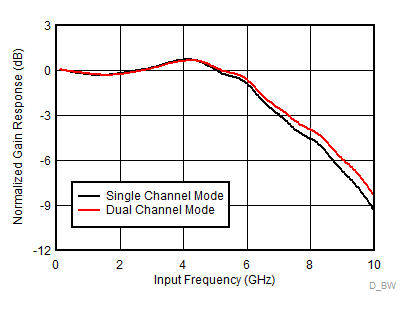JAJSGI4B November 2018 – March 2021 ADC12DJ3200QML-SP
PRODUCTION DATA
- 1 特長
- 2 アプリケーション
- 3 概要
- 4 Revision History
- 5 Pin Configuration and Functions
-
6 Specifications
- 6.1 Absolute Maximum Ratings
- 6.2 ESD Ratings
- 6.3 Recommended Operating Conditions
- 6.4 Thermal Information
- 6.5 Electrical Characteristics: DC Specifications
- 6.6 Electrical Characteristics: Power Consumption
- 6.7 Electrical Characteristics: AC Specifications (Dual-Channel Mode)
- 6.8 Electrical Characteristics: AC Specifications (Single-Channel Mode)
- 6.9 Timing Requirements
- 6.10 Switching Characteristics
- 6.11 Timing Diagrams
- 6.12 Typical Characteristics
-
7 Detailed Description
- 7.1 Overview
- 7.2 Functional Block Diagram
- 7.3
Feature Description
- 7.3.1 Analog Inputs
- 7.3.2 ADC Core
- 7.3.3 Timestamp
- 7.3.4 Clocking
- 7.3.5 Digital Down Converters (Dual-Channel Mode Only)
- 7.3.6 JESD204B Interface
- 7.3.7 Alarm Monitoring
- 7.3.8 Temperature Monitoring Diode
- 7.3.9 Analog Reference Voltage
- 7.4
Device Functional Modes
- 7.4.1 Dual-Channel Mode
- 7.4.2 Single-Channel Mode (DES Mode)
- 7.4.3 JESD204B Modes
- 7.4.4 Power-Down Modes
- 7.4.5 Test Modes
- 7.4.6 Calibration Modes and Trimming
- 7.4.7 Offset Calibration
- 7.4.8 Trimming
- 7.4.9 Offset Filtering
- 7.5 Programming
- 7.6 Register Maps
- 8 Application Information Disclaimer
- 9 Layout
- 10Device and Documentation Support
3 概要
ADC12DJ3200QML-SP デバイスは、RF サンプリング、ギガ・サンプルの A/D コンバータ (ADC) で、DC から 10GHz 超までの入力周波数を直接サンプリングできます。デュアル・チャネル・モードでは、ADC12DJ3200QML-SP は最大 3200MSPS をサンプリングできます。シングル・チャネル・モードでは、最大 6400MSPS をサンプリングできます。チャネル数 (デュアル・チャネル・モード) とナイキスト帯域幅 (シングル・チャネル・モード) のトレードオフをプログラム可能なので、多くのチャネル数を必要とするアプリケーション、または瞬間的に広い信号帯域幅を必要とするアプリケーションのどちらの要求にも対応できる、柔軟なハードウェアを開発できます。フルパワー入力帯域幅 (-3dB) は 7GHz で、使用可能な周波数はデュアル・チャネルでもシングル・チャネル・モードでも -3dB ポイントを超えて拡大されるため、L バンド、S バンド、C バンド、X バンドを直接 RF サンプリングでき、周波数の機動性が高いシステムを実現できます。
ADC12DJ3200QML-SP は、高速の JESD204B 出力インターフェイスを使用し、最大 16 の直列化されたレーンを持ち、決定論的レイテンシとマルチデバイス同期についてサブクラス-1 に準拠しています。シリアル出力レーンは、最大 12.8Gbps をサポートし、ビット・レートとレーン数のトレードオフを設定可能です。革新的な同期機能として、ノイズなしのアパーチャ遅延 (tAD) 調整、SYSREFのウィンドウ処理などがあり、合成開口レーダー (SAR) や位相アレイ MIMO 通信のシステム設計を簡素化できます。デュアル・チャネル・モードではオプションのデジタル・ダウン・コンバータ (DDC) により、インターフェイス速度の低減 (実数および複素数間引きモード) と、信号のデジタル・ミキシング (複素数間引きモードのみ) が可能です。
| 部品番号 | パッケージ(1) | 本体サイズ (公称) |
|---|---|---|
| ADC12DJ3200QML-SP | CLGA (196) CCGA (196) フリップ・チップ |
15.00mm×15.00mm |
 ADC12DJ3200QML-SP で測定された入力帯域幅
ADC12DJ3200QML-SP で測定された入力帯域幅